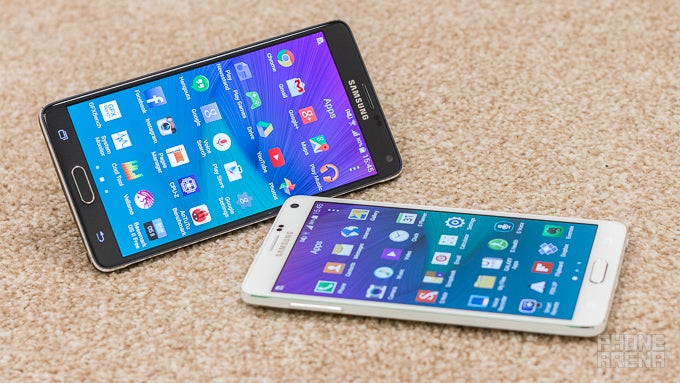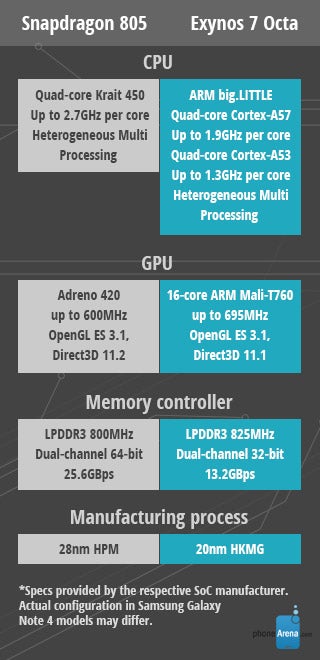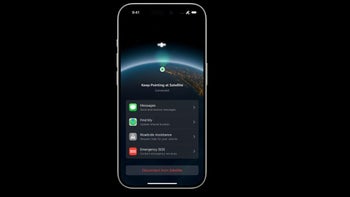Samsung Galaxy Note 4 benchmarks: Snapdragon 805 vs Exynos 7 Octa

It's a fact that for the past several years, Samsung has been producing its flagship phones in multiple variants – one powered by its own Exynos SoC and another featuring a chip from a different supplier, usually Qualcomm. This is also the case with the company's top phablet, the Samsung Galaxy Note 4, which comes with either a quad-core Qualcomm Snapdragon 805 or an octa-core Exynos 7 system-on-chip, depending on the market. Carriers in the U.S., for example, are offering the Snapdragon variant, while the Exynos model is marketed in parts of Europe, Asia, and Latin America.

But that's just the tip of the silicon iceberg. The chips rely on different GPUs – an Adreno 420 and a Mali-T760 for the Snapdragon 805 and Exynos 7 Octa respectively. Thankfully, both of them can handle QHD displays just fine, as well as OpenGL ES 3.1 and Direct3D 11.1, but variations in clock rates and architecture suggest that the GPUs may perform differently.
The list of differences between the hardware inside the two Galaxy Note 4 variants goes on, but we're sure that theory is not what you're here for. So let's move on to the benchmark results and see if they can give us any indication as to which SoC is the better performer.
We chose a total of 8 benchmark tools and suites to compare the Snapdragon 805 against the Exynos 7 Octa – benchmarks that test their single- and multi-core computational power, their 2D and 3D graphics capabilities, their RAM and storage speeds, and their web browsing performance. And to make the race as fair as possible for both phones, we conducted all our testing after resetting the handsets to their factory configuration. Note that the scores presented in the charts below are averages of three runs.
Processor benchmarks
One thing we can say with confidence – both the Snapdragon 805 and the Exynos 7 Octa are equipped with high-powered processors. It is a bit harder to say which one's really better, however, but it looks like the Exynos chip has the upper hand. While AnTuTu favors Qualcomm's silicon, giving it a higher score in most of its single- and multi-core tests, as well as in the UX performance category, Vellamo, Geekbench, Basemark, and PC Mark all give the Exynos 7 Octa a higher score in both their single- and multi-core tests.
Graphics benchmarks
Here's where the Snapdragon 805 shines. During our testing, it tied or outscored the Exynos chip in all of the graphics benchmarks that we ran. These include AnTuTu's 2D and 3D graphics tests, the Basemark graphics benchmark, 3D Mark Ice Storm Unlimited, and GFX Bench's most advanced tests.
RAM and storage benchmarks
RAM performs faster on the Exynos 7 Octa variant of the Samsung Galaxy Note 4, according to our benchmark results. The on-board storage, however, is equally fast on the two devices, pretty much.
Web benchmarks
And when it comes to web browsing, the results are a mixed bag. Vellamo gives the Exynos SoC a higher score, and so does AnTuTu's HTML5 benchmark. But on the other hand, the Snapdragon 805 is faster according to Basemark and SunSpider when ran on the phone's stock browser.
But don't Samsung's phones cheat on benchmarks? – that's what some of you might point out. And while evidence suggests this might have been true in the past, the two Galaxy Note 4 models that we tested did not exhibit any suspicious behavior. One of the tricks that Samsung (and other smartphone makers, for that matter) used to boost their benchmark scores was to lock the CPU clock speed at its maximum level when a benchmark app was detected to be running. This is not the case with either of the Galaxy Note 4 variants – their clock rates are controlled dynamically, as they would be during regular use. Take the screenshots to the right as proof. The widget at the top displays the real-time CPU load and clock speed of the phones while benchmarks are running. (The Snapdragon version is on the left and the one on the right is the Exynos model.)
Conclusion
So, which Samsung Galaxy Note 4 model has the faster SoC – the one with the Snapdragon 805, or the one with the Exynos 7 Octa? Well, it looks like they're both mighty powerful chips, but it is different areas they excel at. The Exynos 7 Octa model of the Galaxy Note 4 scored higher on raw computational scores and had faster RAM performance, which is why we'd expect faster app execution and load times from it. On the other hand, the Snapdragon 805 model dominated the graphics benchmarks, and that leads us to believe that it will be a better gaming device. Yet at the end of the day, we'd say that Samsung has done a good job ensuring that both Galaxy Note 4 models are excellent Android devices with comparable performance as neither of them stood miles ahead of the other in our tests. Regardless of which SoC powers your handset, rest assured that you're not missing out on much.
Software versions of the Galaxy Note 4 units used in this comparison:
Samsung Galaxy Note 4 (Snapdragon 805): Android 4.4.4 build KTU84P.N910FXXU1ANJ4
Samsung Galaxy Note 4 (Exynos 7 Octa): Android 4.4.4 build KTU84P.N910CXXU1ANJ4












Things that are NOT allowed: